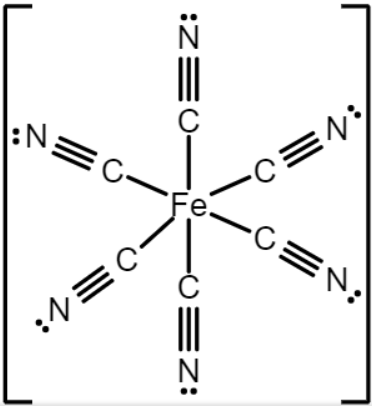
The shape of
A.Hexagonal
B.Pyramidal
C.Octahedral
D.Octagonal
Answer
405.6k+ views
Hint: To find the shape we need to find the hybridization. To find hybridization, first draw the Lewis structure to get a rough idea about the structure of the molecule and bonding pattern. Use the valence concept to arrive at this structure. Concentrate on the electron pairs and other atoms linked directly to the concerned atom. Using the Lewis structure, calculate the number of sigma (
Complete answer:
Number of
The number of lone pairs on a given atom can be calculated by using the following formula.
Number of lone pairs
Where
The Lewis structure of

From the above structure, the central atom of iron (
Hence the geometry\shape of
Thus, the correct option is (C) Octahedral.
Note:
Planarity or nonplanarity is determined by shape/geometry which is further controlled by hybridisation of the central atom in the compound so by knowing the hybridisation we can tell whether a compound is planar or not. Hence, the molecule will not be planar if there is an
| Steric number | hybridization | Structure |
| Linear | ||
| Trigonal planar | ||
| tetrahedral | ||
| Trigonal bipyramidal | ||
| octahedral | ||
| Pentagonal bipyramidal |
Complete answer:
Number of
The number of lone pairs on a given atom can be calculated by using the following formula.
Number of lone pairs
Where
The Lewis structure of

From the above structure, the central atom of iron (
Hence the geometry\shape of
Thus, the correct option is (C) Octahedral.
Note:
Planarity or nonplanarity is determined by shape/geometry which is further controlled by hybridisation of the central atom in the compound so by knowing the hybridisation we can tell whether a compound is planar or not. Hence, the molecule will not be planar if there is an
Recently Updated Pages
Master Class 9 General Knowledge: Engaging Questions & Answers for Success

Master Class 9 English: Engaging Questions & Answers for Success

Master Class 9 Science: Engaging Questions & Answers for Success

Master Class 9 Social Science: Engaging Questions & Answers for Success

Master Class 9 Maths: Engaging Questions & Answers for Success

Class 9 Question and Answer - Your Ultimate Solutions Guide

Trending doubts
Give 10 examples of unisexual and bisexual flowers

Draw a labelled sketch of the human eye class 12 physics CBSE

Differentiate between homogeneous and heterogeneous class 12 chemistry CBSE

Differentiate between insitu conservation and exsitu class 12 biology CBSE

What are the major means of transport Explain each class 12 social science CBSE

Why is the cell called the structural and functional class 12 biology CBSE




